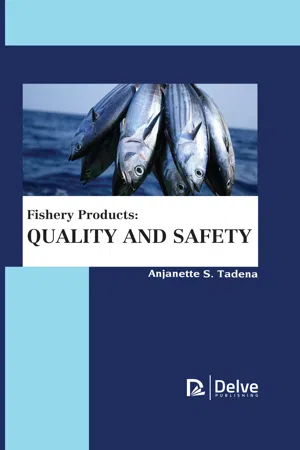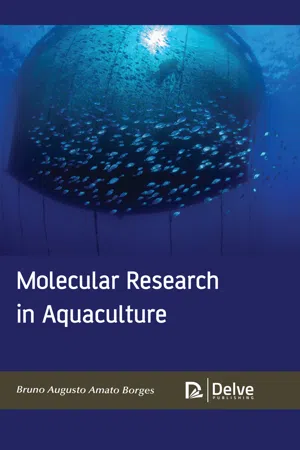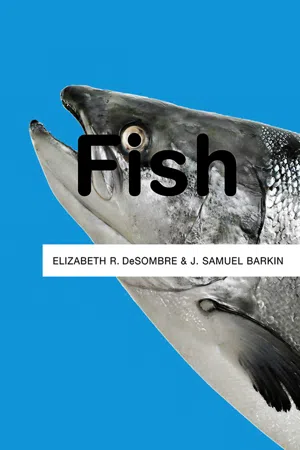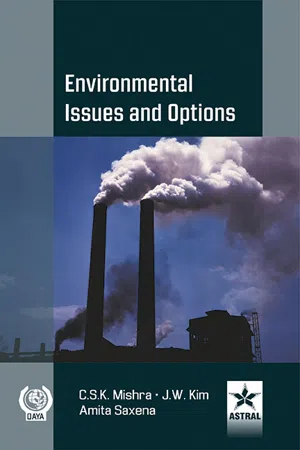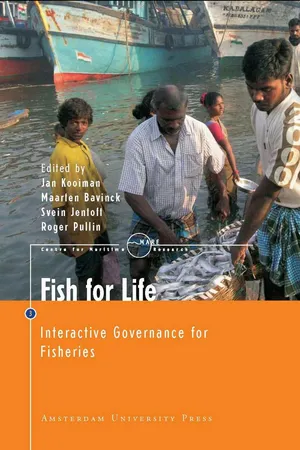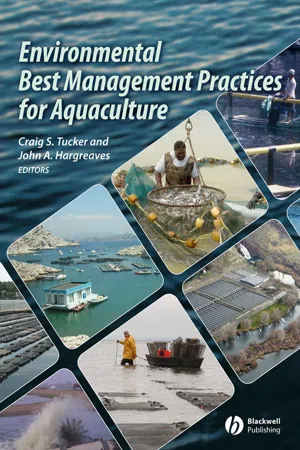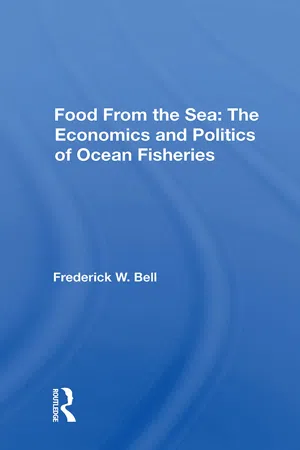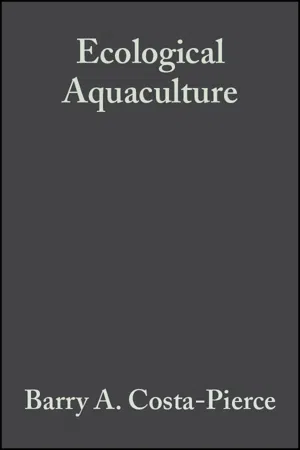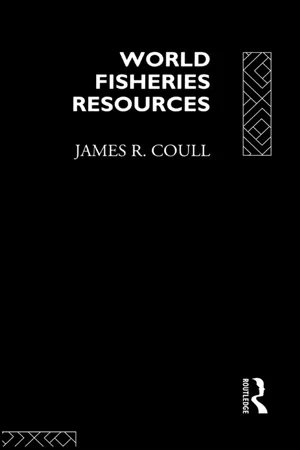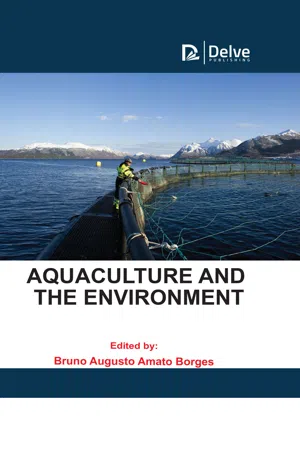Geography
Aquaculture
Aquaculture is the practice of cultivating aquatic organisms such as fish, shellfish, and seaweed in controlled environments. It involves the breeding, rearing, and harvesting of these organisms in ponds, tanks, or ocean enclosures. Aquaculture plays a significant role in providing food security, supporting livelihoods, and reducing pressure on wild fish populations.
Written by Perlego with AI-assistance
Related key terms
1 of 5
11 Key excerpts on "Aquaculture"
- eBook - PDF
Fishery Products
Quality and Safety
- Anjanette S. Tadena(Author)
- 2019(Publication Date)
- Delve Publishing(Publisher)
Aquaculture is also called as aquafarming, which is the farming of algae, aquatic plants, mollusks, crustaceans, and fish. Aquaculture includes cultivation of saltwater and freshwater populations under the stabilized conditions. These can be opposite to the commercial fishing, which is the harvesting of wild fish. This agricultural is defined as Aquaculture in the marine-based environment as well as in the underwater habitats. As per the Food and Agriculture Organization, the Aquaculture is considered to mean the agriculture and farming of aqua organisms that include aquatic plants, crustaceans, mollusks, and fish. Farming includes intervention or involvement in the rearing process for enhancement of production like regular protection, feeding, and stocking from the predators, etc. It also implies corporate or individual ownership of the stock, which is being cultivated (Figure 1.6). Fishery Products: Quality and Safety 12 Figure 1.6: Global fish production, ( Source: http://www.fiskerforum.dk/en/ news/b/global-fish-production-set-to-grow-further ). The reported output from global Aquaculture operations in 2014 supplied over one half of the fish and shellfish that is directly consumed by humans; however, there are issues about the reliability of the reported figures. Furthermore, in present Aquaculture practice, the goods from various pounds of wild fish are being used for producing one pound of a piscivorous fish such as salmon. Specific kinds of Aquaculture involve cultivation of ornamental fish, algaculture (like seaweed farming), Mari cultural, oyster farming, shrimp farming, and fish farming. Specific methods involve integrated multi-trophic Aquaculture and aqua phonics, both of which collate aquatic plant farming and fish farming. Aquaculture is defined as farming of aquatic organisms such as crustaceans, mollusks, aquatic plants, and fishes. - eBook - PDF
- Bruno Augusto Amato Borges(Author)
- 2019(Publication Date)
- Delve Publishing(Publisher)
In another form of definition, Aquaculture has been described as “the art of cultivating the natural yield in water, which may involve rearing and looking after the fishes in ponds that comprise a constrained environment. “There are even more definitions of Aquaculture , one of which states that it is “large-scale husbandry or rearing of aquatic organisms for commercial purposes.” Aquaculture acts a significant medium in bringing up and using animals wisely, in a controlled way, for the benefits of humans in commercial ways. Figure 1.1: Aquaculture cages in the bay of Luoyuan. Source: https://live.staticflickr.com/4014/4478993436_c501b6dc0a_z.jpg Introduction to Aquaculture 3 Aquaculture is a huge contributor to the job market, contributes to the sport and commercial fishing industry in a significant way and serves as a huge source of protein that is dependable from the future perspective. Fish acts as a rich source of protein in the animal form and the agriculture practices concerning fish take the form of a great food production system that originates from the aquatic environment. The main job of fish in Aquaculture is its roleplay in the improving the nutritional value of food that the people have. This form of agriculture also involves making use of the land and water resources in a sustainable way. The field of Aquaculture provides the reasons and incentives to introduce other related industries in a nation. The field of Aquaculture turns out to be the singular medium that can be relied upon to maintain the overall supplies by undertaking several management processes such as management of hatcheries, management of quantity of water, management of brood stock, management of the nursery ponds, management of seed farms, and so forth. 1.2. HISTORY Asia, specifically China, has commanded Aquaculture improvements on the planet directly through history. The principal known ‘Treatise in Fish Culture’ was composed by Fan Li in 476 BC. - eBook - ePub
- Elizabeth R. DeSombre, J. Samuel Barkin(Authors)
- 2013(Publication Date)
- Polity(Publisher)
CHAPTER FIVE AquacultureAquaculture is the technical term for fish farming. It is not a new phenomenon – on the contrary, it has been around for millennia. But it has expanded rapidly over the past few decades, both in the volume of fish farmed, and in the breadth of species farmed. The proportion of the world’s total seafood production accounted for by Aquaculture increased from 13 percent to more than 35 percent in the period between 1990 and 2007.1 With the production of the global capture fishery having peaked at a little over 90 million tonnes a year, all of the growth in global production of seafood comes from the rapidly growing Aquaculture sector. To the extent that global capture fisheries are at or near (or even beyond) their maximum sustainable yield, future growth in the supply of fish and other seafood can be expected to come exclusively from Aquaculture.This sector is dominated by developing countries. China alone accounts for almost two-thirds of the global total Aquaculture production as measured by weight (although under half by value), and the top five Aquaculture producers globally – India, Vietnam, Indonesia, and Thailand follow China – are all developing countries (again by weight; measured by value Japan comes in fifth).2 A large majority of the world’s fish farming happens in Asia – almost nine-tenths by weight, and about three-quarters by value. The differences between weight and value are caused by the different kinds of Aquaculture practiced in different places. Most of the fish farmed in Europe and North America are species that have a high price per weight, such as salmon and oysters, whereas much of the Aquaculture in Asia is of lower-value species such as carp, grown with less capital for a more local market.The range of activities undertaken under the heading of Aquaculture, and the range of scales on which it is practiced, is as broad as for capture fisheries. The range extends from small ponds in which a few herbivorous fish, such as carp or tilapia, are raised for local consumption, to massive industrial operations, involving millions of fish, that raise open-water predator species in pens at sea. Many Aquaculture practices, including the small-scale fish pond example, are essentially benign. But as the scale of fish farming operations increases, and as it comes to involve species that are higher up the food chain, potential problems associated with Aquaculture multiply. Unfortunately, it is the species that have the greatest value on the global market, such as salmon, shrimp, and tuna, that generate the greatest environmental challenges. These challenges include pollution from high concentrations of animals in confined spaces, the spread of disease among confined and in-bred populations, ecosystem disruptions, and threats to the biological integrity of the species in the wild. - eBook - PDF
- Mishra, C S K(Authors)
- 2021(Publication Date)
- Daya Publishing House(Publisher)
Aquaculture, the farming of aquatic organisms such as fish, crustaceans and plants, is the fastest growing food production sector in the world, but its sustainability is not assured. Pollution, destruction of sensitive coastal habitats, threats to aquatic and significant socio-economic costs must be balanced against the substantial benefits. Aquaculture has great potential for food production and the alleviation of poverty for people living in coastal areas, many of who are among the poorest in the world. A balance between food security and the environmental costs of production must be attained. Impacts of Aquaculture on Environment The use of natural resources by Aquaculture has had environmental implications in many areas. Destruction of wetlands, wild capture of larvae and broodstock, heavy use of water, chemicals and fishmeal are prominent in case of shrimp farming (Clay, 2001). The social impacts include privatization This ebook is exclusively for this university only. Cannot be resold/distributed. of public resources, elimination of access to remaining resources and displacement of local populations. Major environmental concerns about pond Aquaculture and shrimp farming in particular include: disruption of mangrove forests and other wetlands; eutrophication and sedimentation in natural water bodies caused by pond effluents; salinization of freshwater areas; use of toxic and bioaccumulative chemicals in production; conversion of croplands into ponds; excessive use of resources such as water, foodstuffs, negative effects on natural fisheries and biodiversity (Boyd 1999). In recent years, Aquaculture has expanded rapidly in the tropics, especially in Southeast Asia and Latin America. Most of this expansion has resulted from shrimp farming, often in ponds excavated in coastal mangrove environments. The intensive production of shrimp has led to pollution from pond effluents, land subsidence, saltwater contamination and the destruction of mangrove wetlands. - eBook - PDF
- Jules Pretty, Andy Ball, Ted Benton, Julia Guivant, David R Lee, David Orr, Max Pfeffer, Professor Hugh Ward, Jules Pretty, Andy Ball, Ted Benton, Julia Guivant, David R Lee, David Orr, Max Pfeffer, Professor Hugh Ward(Authors)
- 2007(Publication Date)
- SAGE Publications Ltd(Publisher)
28 Regenerating Aquaculture – Enhancing Aquatic Resources Management, Livelihoods and Conservation S t u a r t W. B u n t i n g INTRODUCTION Aquaculture, broadly defined as the farming of aquatic species, has emerged as an important food producing sector. The Food and Agriculture Organisation of the United Nations (FAO, 2004) noted that since 1970 total Aquaculture output grew at an average of 8.9% per year until 2002, as compared with 2.8% for terrestrial livestock farm-ing and 1.2% for capture fisheries over the same period. Furthermore, finfish and shellfish farming expanded at rates of 9.1 and 5.8% per year between 1995 and 2000, reaching production levels glob-ally of 23.2 and 12.4 million tonnes, respectively; farmed fish, crustaceans and molluscs represented 27% of global supplies in 2000 (FAO, 2002a, b). Despite rapid population growth, Aquaculture pro-duction per capita increased from 0.7 kg in 1970 to 6.4 kg in 2002; the number of people economi-cally active in the sector in 2002 was 9.8 million and production (including plants) was worth US$60 billion (FAO, 2004). However, global figures, dominated by fresh-water Aquaculture production in China, conceal the fact that farming marine finfish accounts for a small proportion, less than 5% in 2000, of that consumed by humans. Moreover, aquatic foods do not necessarily readily substitute for meat and livestock products and farming marine fish and shrimp can constitute a net protein consumer (Naylor et al ., 2000; Muir, 2005). Aquaculture also appropriates a wide range of environmental goods and services (Berg et al ., 1996; Beveridge et al ., 1997; Kautsky et al ., 1997; Folke et al ., 1998; Bunting, 2001a) and where demand exceeds the environmental carrying capacity adverse impacts are observed: physical and chem-ical environmental parameters may be affected; eutrophication can occur; species abundance and diversity may be changed. - eBook - PDF
Fish for Life
Interactive Governance for Fisheries
- Jan Kooiman, Svein Jentoft, Roger Pullin, Maarten Bavinck, Jan Kooiman, Svein Jentoft, Roger Pullin, Maarten Bavinck(Authors)
- 2005(Publication Date)
- Amsterdam University Press(Publisher)
5 Aquaculture Roger S.V. Pullin and U. Rashid Sumaila Diversity, Complexity, and Dynamics in Aquaculture Aquaculture, the farming of aquatic plants and animals (finfish, crusta-ceans, molluscs and other invertebrates), in fresh-, brackish, and seawater, is very diverse (Stickney 2000). Aquaculture statistics reported to the FAO from its member countries in 2000 covered 210 different species (Tacon 2003). Aquaculture systems are commonly classified according to their nu-trient inputs. Extensive Aquaculture involves no intentional fertilisation or feeding; e.g., the capturing of naturally settled mussels and oysters. Semi-intensive Aquaculture comprises the farming of fish and invertebrates in ponds, pens and cages with supplementary fertilisation and/or feeding. In-tensive Aquaculture is entirely reliant on added feeds (e.g., salmon cages, eel tanks and raceways) and resembles feedlot systems for livestock. Fish farmers are also diverse. They range from poor smallholders in developing countries to the world ’ s largest corporations. Their operations range in scale from backyard ponds of less than 100 m 2 , operated by rural and peri-urban households, to enterprises that cover thousands of hectares of land and water with ponds, pens and cages. Aquaculture is as diverse as agricul-ture. Aquaculture, like agriculture, is also a highly complex sector, comprised of sub-sectors (breeding, hatchery and nursery operations, grow-out and marketing, etc.) and interdependent with a wide range of associated indus-tries; e.g., feeds, fertilisers, medication, and equipment. The diversity and complexity of Aquaculture inevitably make it a very dynamic sector. Its dy-namics include its rapid growth, as a new frontier for food production in many countries, and its necessary coexistence with other longer established sectors. - Craig S. Tucker, John A. Hargreaves, Craig S. Tucker, John A. Hargreaves(Authors)
- 2009(Publication Date)
- Wiley-Blackwell(Publisher)
For thou-sands of years Aquaculture was practiced as a relatively low-input activity and was seen as a beneficial or, at worst, benign endeavor that provided high-quality animal protein for families or local communities. Much of current Aquaculture remains rooted in these ancient practices. Countries in Asia and the western Pacific region presently account for approxi-mately 90% of the world Aquaculture production, and much of that activity is based on pond Aquaculture of grass carp ( Ctenopharyngodon idella ), silver carp ( Hypophthalmichthys molotrix ), bighead carp ( Aristichthys nobilis ), and common carp ( Cyprinus carpio )—the same species raised in traditional pond Aquaculture in China thousands of years ago. In fact, freshwater pond culture of cyprinids for local consumption accounts for almost a third of global Aquaculture production, including plants (FAO 2006b). As Aquaculture production rapidly increased in the last half of the 20th century, culture methods and technologies evolved in response to profit incentives and encouragement from Aquaculture development agencies. In many instances, the goal of supplying food for local consumption changed to that of producing higher-value products for export. Associated with this trend was the use of culture practices with higher rates of resource use and greater environmental impacts than traditional Aquaculture methods. The rapid expansion of Aquaculture development occurred during a time of heightened environmen-tal awareness and advocacy, and well-publicized problems in certain sectors led to closer scrutiny of Aquaculture in general. Aquaculture and the Environment in the United States 5 Based on real and perceived environmental impacts, some critics believe that aquacul-ture cannot—and should not—meet the increasing global demand for seafood. In one respect this argument is moot because capture fisheries clearly cannot grow to meet the demand.- eBook - PDF
Food From The Sea
The Economics And Politics Of Ocean Fisheries
- Frederick W. Bell(Author)
- 2019(Publication Date)
- Taylor & Francis(Publisher)
The fact that Aquaculture output has approximately doubled over the last five years and the fact that some countries already rely upon Aquaculture for up to 50 percent or more of their total fisheries production-both portend an im-portant future for Aquaculture. The reasons for the recent and projected rapid growth of aqua-275 276 Aquaculture culture activities are (1) the growing and incessant world demand for protein; (2) the rising costs of commercially caught fish as maximum sustainable yields of more and more wild stock species are approached or exceeded; and (3) Aquaculture's more favorable feed conversion rates and higher productivity per hectare than in traditional agricultural methods and products. It is clear that world Aquaculture is well beyond the purely experimental stage. Profitable technologies exist that can and are being transferred within and among various countries. The world protein demand and food supply problems are bound to force the continuation of Aquaculture technology transfer and technology enhancement. The purpose of this chapter is to give a brief survey of current world Aquaculture and to introduce the reader to the fundamental biological and economic factors that interact to produce a success-ful or profitable fish farm. We shall also ask whether the waters of the earth may still be a panacea for the continuing imbalance between population and food supplies, which has been a recurring theme of this book. Present World Aquaculture: Extent and Distribution A World Survey The exact extent of world Aquaculture is not fully known. The problem is partly definitional. At what point does wise and care-ful management of wild natural resources shade off into the farm-ing of freshwater and marine organisms? But the problem is mostly one of measurement. - eBook - PDF
Ecological Aquaculture
The Evolution of the Blue Revolution
- Barry A. Costa-Pierce(Author)
- 2008(Publication Date)
- Wiley-Blackwell(Publisher)
Methods for the Development of Sustainable Aquaculture Ecosystems 105 mental enhancement on local and regional scales. When viewed from these commu-nity development perspectives, Aquaculture and the public it intends to serve have many common objectives. Edwards (1993) states that the `problem for developing countries is essentially how to stimulate agricultural (and Aquaculture) productivity and profitability without further environmental degradation, in contrast to the need to reduce the level of intensification to a sustainable level in the developed world.' As an infant enterprise the world over, Aquaculture can ill afford to recreate the evolution of commercial agriculture in the mid-twentieth century where huge, toxic, nutrient and chemical loading were washed down a primitive path of the `solution to pollution is dilution'. Rather, modern Aquaculture should adopt a new strategy, a model of `community-based, ecologically sustainable Aquaculture' that produces certified organic produce, similar to a strategy promoted in agriculture and industry called `input management' (Odum, 1989). Folke & Kautsky (1991) state, `One must expand the boundaries and one's actions far beyond the cultivation site, and realize that there is an unavoidable complementarity between the life-support environment and Aquaculture production'. In addition, it is also essential to consider the social ecology of Aquaculture developments from the outset in order to articulate what are the most important development goals for sustainable Aquaculture systems, and to define what will be required socially in order to develop community-based aqua-culture ecosystems and `green' marketing approaches (ecolabelling, sustainable cer-tification, etc.). - eBook - ePub
- James R. Coull(Author)
- 2002(Publication Date)
- Taylor & Francis(Publisher)
In the utilisation of living resources there has been a long-term trend of a transition from gathering or hunting to cultivation or husbandry. The essential basis of support for the large majority of the human species for thousands of years has been farming rather than hunting or gathering, and hunting and gathering as cultures have in general survived into the modern period in areas unsuited by climate or relief to farming; these cultural forms have also survived in some isolated locations, as in Australia before European settlement. The main source of food, and of some necessary materials for most human societies, has been the raising of crops, whether from seeds or from cuttings: and this has been supplemented in most cases by livestock husbandry, as a source both of food protein and of necessary materials like wool and hides. Domesticated livestock also played essential roles in pre-industrial societies in both transport and traction. While systems of farming, including both domesticated crops and livestock, are known to have evolved over more than 10,000 years, fish farming was slower to appear, and conventional fishing, which is still culturally at the stage of hunting and gathering, continues to provide the major part of the world’s fish supplies. However, fish farming in fresh water is known to have been practised for over 3,000 years in the case of China, and was known in some degree in classical times in the Mediterranean world, where it extended to some farming of the edge of the sea for the oyster species, as it also did in the Far East. In much of Europe there was an expansion in fish farming from the Medieval period, and relatively sophisticated pond management had developed by the fifteenth century (Matena and Berka 1987:4-5).More broadly, Aquaculture, which includes the husbandry of aquatic plants as well as fish, has been an expanding activity in recent decades in both developed and developing countries. In the poorer countries, especially those of south and east Asia, Aquaculture has been seen as one of the most feasible means of improving diets by providing an adequate source of food protein. Moreover, general levels of income have been rising sufficiently fast in the Asian-Pacific region to create a strong demand and to suggest that the increasing commercial market in farmed fish is likely to absorb increases in production for the foreseeable future without significant reductions in real price. In developed countries recent decades have witnessed a marked development of a more sophisticated and intensive fish farming, where technical advance allied to strong market demand has encouraged investment, innovation and expansion.Even the most productive conventional fisheries have a poor yield per unit area compared with land-based farming, and especially compared with cropping, in which the vegetable product is used directly and does not have to pass through another trophic level in the food chain, as it does with livestock farming. Fish farming on the other hand generally compares favourably with livestock farming in productivity per unit area, and can even compare very well with staple grain crops like wheat and rice; in eel farming in Japan regular yields of well over 20 tonnes/ha per year have been reported (Doumenge 1986:465), and yields of from 5 to 10 tonnes/ha per year and over have been reported for several other species including carp, tilapia and panaeid shrimp. One factor that renders fish farming more efficient than most livestock farming is that fish, being cold blooded, can put into growth that part of the feed which in farm livestock is used to maintain body temperature. As a rule Aquaculture actually gives a higher yield of protein in relation to metabolisable energy than farm livestock: it has been found, for example, that trout give 30-40 g protein/Mcal compared with comparable figures of 2 for cattle, 6 for pigs and 15 for chickens. This has implications not only in the efficiency in the conversion of feed, but also for other energy use in fuel and machinery (Bardach 1978:425). However, fish farming cannot thus far compare with the rearing of broiler chickens, which has become the most intensive means of production of protein food in developed countries in the last three decades. With a stocking density of 23 kg/m2 - eBook - PDF
- Bruno Augusto Amato Borges(Author)
- 2019(Publication Date)
- Delve Publishing(Publisher)
SECTION I: Aquaculture: DEVELOPMENT APPROACH TO SUSTAINABILITY GLOBAL ESTIMATION OF AREAS WITH SUITABLE ENVIRONMENTAL CONDITIONS FOR MARICULTURE SPECIES 1 CHAPTER Muhammed A. Oyinlola 1 , Gabriel Reygondeau 1 , Colette C. C. Wabnitz 1 , Max Troell 2,3 , William W. L. Cheung 1 1 Nippon Foundation-Nereus Program and Changing Ocean Research Unit, Institute for the Oceans and Fisheries, The University of British Columbia, Vancouver, Canada, 2 Stockholm Resilience Centre, Stockholm University, Stockholm, Sweden, 3 The Beijer Institute, The Swedish Royal Academy of Sciences, Stockholm, Sweden ABSTRACT Aquaculture has grown rapidly over the last three decades expanding at an average annual growth rate of 5.8% (2005–2014), down from 8.8% CITATION : Oyinlola, M.A., Reygondeau, G., Wabnitz, C.C.C., Troell, M., Cheung, W.W.L. Global estimation of areas with suitable environmental conditions for mariculture species. PLoS ONE, 2018, 13: (1): e0191086. https://doi.org/10.1371/journal. pone.0191086. COPYRIGHT: © 2018 Oyinlola et al. This is an open access article distributed under the terms of the Creative Commons Attribution License, which permits unrestricted use, distri-bution, and reproduction in any medium, provided the original author and source are cred-ited. Aquaculture and the Environment 4 achieved between 1980 and 2010. The sector now produces 44% of total food fish production. Increasing demand and consumption from a growing global population are driving further expansion of both inland and marine Aquaculture (i.e., mariculture, including marine species farmed on land). However, the growth of mariculture is dependent on the availability of suitable farming areas for new facilities, particularly for open farming practices that rely on the natural oceanic environmental parameters such as temperature, oxygen, chlorophyll etc.
Index pages curate the most relevant extracts from our library of academic textbooks. They’ve been created using an in-house natural language model (NLM), each adding context and meaning to key research topics.
